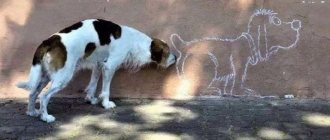Fleas are blood-sucking insects that parasitize the skin of warm-blooded animals, which means not only animals and birds, but also humans. It is accepted that dogs are parasitized by the “dog” flea - Ctenocephalus canis.
However, the most common type is the “feline” one - Ctenocephalides felis felis, they are most often found on cats and dogs, and therefore on humans. It is on cat fleas that the effect of new drugs is tested (if it works on them, it will work on other fleas).
general information
These parasites are wingless, but they do not need wings. They can jump 35 centimeters in height, and 18 centimeters in length. Therefore, even if you are sure that there cannot be fleas in your house and the dog could not pick them up, then they can perfectly well “come” to you on their own.
Fleas undergo a complete transformation in their development. This means that an adult individual lays eggs (in fact, she doesn’t just lay them, but literally shoots them at some distance from herself), from which, under favorable conditions, a larva hatches; after a while, after several molts, it becomes a pupa, and from there an adult emerges.
At the pupal stage, it is worth paying special attention, since thanks to this, fleas can survive in the external environment for a long time. Pupae can survive in this state for up to two years and are difficult to destroy. The adult hatches instantly under good external conditions. Also, vibration and noise encourage them to wake up, so they “understand” that there may be food nearby.
If there is a host, fleas live up to 100 days, and lay 40 - 50 eggs per day.
It is very important to know that fleas do not live on dogs and other animals, they only feed on them. Therefore, you should not think that “hairless” dogs, such as Chinese Cresteds, cannot have fleas. They really can.
And they hide in the environment, in the house these are carpets, baseboards, furniture and other hard-to-reach places. If these parasites constantly live on a dog, this means that their number has reached a very large scale.
Many people do not realize the dangers that these parasites pose.
Only one adult can drink up to one milliliter of blood per day. For a large dog this may not mean anything, but for puppies and representatives of dwarf breeds it is very harmful. Considering that up to several dozen fleas feed on one dog, this leads to significant blood loss.
In addition, fleas are carriers of some infections, but they also transmit helminths, namely the cucumber tapeworm. This parasite can be found in feces (or on the fur around the anus if the dog has thick hair) and looks like cucumber seeds or flattened rice.
Many dogs have an innate hypersensitivity to flea saliva, and just a few bites are enough to trigger an allergic reaction called flea dermatitis. The dog is constantly itching and its hair is falling out. Allergy to flea saliva is the most common allergy today.
Why did fleas appear on my domestic dog?
Bloodthirsty parasites can appear even in a domestic, clean, well-groomed dog. A pet can become infected through direct contact with a sick animal .
IMPORTANT ! Fleas have the ability to jump at a distance of more than 30 centimeters, both in length and height, so they can move onto the skin of a pet even when the animals sniff each other. An infected animal, shaking itself off, can shed flea eggs or larvae from its fur anywhere.
Insect larvae can be anywhere: in foliage, on grass, and even on bare ground , and a dog can pick them up simply by walking on a leash in the yard or in the park.
Larvae and flea eggs can stick to the soles of shoes and thus enter the house and then directly onto the animal. A previously ill animal may become re-infected after a course of treatment .
Signs of fleas on a dog:
- visible bites on the skin;
- the dog began to itch frequently;
- premature shedding;
- hair loss in certain areas of the skin;
- accumulation of white larvae on the fur;
- uncharacteristic behavior for a dog (irritability, loss of appetite, allergies).
ATTENTION ! Delayed treatment or inaction in this situation can lead to more serious illnesses and infections. Typhoid fever, tick-borne encephalitis, tuberculosis, salmonellosis - this is an incomplete list of diseases caused by fleas and can easily be transmitted to humans. The bites of such insects are quite painful. Fleas can carry on their bodies the larvae of various types of helminths susceptible to the human body.
Sources
- https://sichovka.ru/parazity/blohi-u-shchenka.html
- https://lifeinsect.ru/blohi-ot-sobaki-k-cheloveku.html
- https://kinpet.ru/kak-vyvesti-blokh-u-sobak-prichiny-poyavleniya-parazitov-i-sposoby-lecheniya/
- https://mybarbos.com/blohi-u-sobak/
- https://clubsobak.ru/2019/12/22/priznaki-bloh-u-sobaki/
- https://lapkins.ru/p/kak-bystro-vyvesti-blokh-u-sobaki/
- https://pets-mf.ru/priznaki-blox-u-sobak/
- https://pets-expert.ru/sobachya-bloxa-kak-izbavitsya/
- https://PetGuru.ru/zdorovie/blohi-u-sobaki
- https://esliotravilsya.ru/zhivotnye/kak-raspoznat-peredozirovku-sredstvami-ot-bloh-u-pitomtsa
- https://GdeKlop.ru/blohi/sobachya/
- https://TaraKlop.ru/blohi/blohi-ot-sobaki-k-cheloveku/
- https://stopvreditel.ru/parazity/zhivotnyx/bolezni-u-sobak.html
- https://rusfermer.net/dom-kvartira/blohi/sobaki
[collapse]
How do dogs get fleas?
The main thing to understand about this issue is that there are FLEAS EVERYWHERE, even if you don’t see them.
A dog can pick up a parasite:
- in contact with other animals;
- just on the street;
- you can bring them on your shoes (completely unnoticed by yourself);
- when using care products for other animals;
- at home, especially if you live on the ground floor, in a house with a basement, in which case it will be very difficult to get rid of them.
Your dog may be bitten by fleas, even if it has never left the house and in general you live on a high floor and the house is elite.
After all, no one canceled neighbors with animals going outside, and we already know that the threshold for this parasite is not a problem. Yes, and you yourself can inadvertently drag this insect home.
Preparing to kill parasites
It is necessary to get rid of parasites as soon as possible. They multiply rapidly, and soon there will be dozens or even hundreds of eggs laid , from which maggot-fly-like larvae will hatch and quickly grow into ready-to-breed adults.
Removal of blood-sucking insects should begin with preparatory work:
- Wash in hot water or throw away the bedding on which the animal sleeps.
- Check the apartment, and if there is a possibility of infection, carry out disinfestation.
- Find out from the veterinarian whether or not your pet has allergic reactions to flea medications.
The choice of drugs that will help get rid of parasites depends on the age of the dog and the degree of its infection. Pregnancy, lactation, and whether the pet is taking other medications also matter.
If your dog has fleas, but there are still only a few of them, you can use mechanical means to remove them. To do this, the animal is washed for ten minutes using tar or laundry soap, dried and the hair is combed out with a fine comb.
In case of severe infestation, the dog will have to be treated with insecticidal preparations.
How can you tell if your dog has fleas?
With a high probability, your animal will not show any symptoms if there are not very many parasites and your pet is not hypersensitive to their saliva (in this case, flea dermatitis will develop very quickly - debilitating itching, hair loss in large quantities, so much so that bald patches form) .
But here are some signs you may notice:
- The dog may be itching, and if at this moment you examine the scratching area, you will most likely see the culprit, namely the flea itself.
- Very often you can notice black grains on the dog’s skin and fur, sometimes they can even fall off the pet after it lies somewhere. This is flea feces. To make sure of this, you can do a "wet paper test" for this: comb out these grains onto a slightly dampened piece of paper. They will dissolve and leave behind red-brown marks, since the feces of these parasites are digested blood.
- If you notice small white worms, the size of rice, similar to cucumber seeds, in your dog’s feces, then this is a helminth - cucumber tapeworm, they can move, or they can be motionless. Their presence in most cases indicates that your pet has fleas, since they are the carriers of these helminths.
- You may find bite marks on yourself, most often on your legs.
- In dwarf breeds and puppies, with a large number of fleas, anemia (anemia) develops. In this state, their mucous membranes turn pale and there is severe weakness. May cause death.
How to withdraw?
Attention! Do not self-medicate; if there is any deviation from the norm, consult a specialist!
In the modern world, this will not be difficult; it is important to choose the right remedy, and we will help you with this.
It is necessary to treat not only animals, but also the environment; for domestic dogs, this is an apartment or a house. Let us remind you once again that fleas do not live on animals, they only feed on them.
How to choose a product for your pet?
The following factors need to be considered:
- Kind of animal. If you have both a dog and a cat, they will need different products, because what the dog tolerates well can be extremely toxic for the cat.
- Age.
- Breed. The fact is that some breeds have their own characteristics, due to which substances, for example ivermectin, can be deadly to them. We'll talk about this in more detail later.
- Lifestyle , because for dogs that are constantly in the house and for hunting dogs, different concentrations of the active substance are required.
- Health conditions. If your pet is hypersensitive to insect saliva, then you should carefully select the drug; sometimes it is more convenient to combine several products at once.
- Ease of use , you yourself should feel comfortable and safe.
Forms of antiparasitic drugs
Drops
Pros: easy to apply. The active substance is independently distributed over the entire surface of the skin. Effect from one to two months (depending on the active substance).
Cons: since the drug is applied to the skin, a contact reaction is possible, in other words, an allergy. Low water resistance, which means it is not suitable for dogs that need to be bathed frequently, such as show dogs or hunting dogs. If the dog is not alone in the house, they can lick the substance off each other. And even the dog itself can get so clever that it licks everything off itself, and this threatens poisoning. Many owners complain that a greasy stain remains on the fur at the site of application, and this looks untidy.
Collar
It is recommended for use only in combination with other forms of the drug.
Pros: convenient. Repels parasites.
Cons: many people put it on the dog incorrectly. The collar should always be in close contact with the skin (two fingers should pass between the collar and the skin to make the pet comfortable), and not just dangle on the fur. And therefore not suitable for breeds with thick, long hair. The dog might eat it. Don't be surprised, there are more such cases than you think. And this threatens the pet with poisoning and surgery is required to remove the foreign body from the stomach. A contact reaction is also possible.
Pills
New products are on our market and therefore cause a lot of controversy.
Pros: convenient. Effective for a long time, up to three months. Very high efficiency. The action does not depend on external factors. Conducted studies prove safety.
Cons: no long-term studies, as the active ingredient is new generation. There is a lot of controversy around them, which causes distrust among many owners, despite proven safety and positive prospects.
Spray
Mainly used for puppies and small breeds.
Pros: Highly effective when applied correctly.
Cons: not convenient to apply. The active substance is not distributed over the skin on its own, which means it must be applied to the entire surface of the body. Due to the inconvenience of application, there is a risk of overdose. Dangerous for the owner. It is necessary to handle the animal with gloves, and in some cases with a respirator.
Shampoo
Cons: effective only at the moment of application. Doesn't protect or fight fleas after bathing. Contains pyrethroids - substances that are extremely toxic to cats (even fatal), and there are cases that owners who have both dogs and cats at home buy dog shampoo and at the same time wash their cat with it, without even suspecting that they are poisoning the animal.
Differences in drugs by action
Repellents have a repellent effect. Drugs with this effect are very helpful for dogs with hypersensitivity (flea dermatitis). They affect the flea even before it bites the animal. But the duration of action is short, usually 2 weeks.
The cidial effect is killing. It can be contact and systemic. In the first case, the parasite dies upon contact with the skin, and in the second only after a bite (the active substance is absorbed into the blood and then accumulates in the skin).
Desterilizing, sterilizing. Not only does the adult stop laying eggs, but each form of development cannot move on to the next. The eggs do not hatch into larvae. The larva does not become a pupa, and the pupa cannot become an adult.
Active substance
Pyrethroids. Substances used in this series: Permethrin, Flumethrin (the only one from this series that is safe for cats), Phenothrin, Deltamethrin. These substances are included in drops, sprays, collars and shampoos, such as Advantix, Deltsid, Frontline, Scalibor. Can be used from 7 to 10 weeks.
- They have a killing effect.
- They affect not only fleas, but also ixodid ticks.
- They are destroyed when exposed to water or sun.
- Parasites develop resistance
- TOXIC TO CATS.
Amitraz. It is included in the drops and solutions of the preparations “Certifect” and, in fact, “Amitraz”. Used from 4 months!
- It has both a killing and repellent effect.
- Against ixodid ticks.
- It has a lot of side effects that occur not only in animals, but also in people.
Insect growth regulators are artificial analogs of insect hormones. In the form of drops, sprays and collars, for example “Rolf”, “Frontline”.
- De-fertilizing effect prevents fleas from developing.
- Safe.
- Fleas develop resistance.
- It does not work immediately, often only for the next generation.
Neonicotinoids. Substances contained in tobacco leaves. Found in drops on the withers and collars “Advantix”, “Advocate”, “Vectra3D”. Used from 7 weeks.
- Killing action. Causes the effect of “burnt paws”.
- Safe.
- Weakly effective against ixodid ticks.
Phenylpyrazones. Found in collars, sprays and drops “Certificate”, “Frontline”, “Effitics”, “Prac-tic”. They are used from 7 weeks, and Frontline spray is allowed from the 2nd day of life.
- Safe.
- Killing and repellent effect.
- Against ixodid ticks.
- Resistant to washing off.
- If, in addition to a dog, you also have a rabbit, then the problem is that phenylpyrazones are toxic to rabbits!
Carbamates are part of Bolfo collars and sprays. Allowed from 6 weeks.
- Works against ixodid ticks.
- Killing and repellent effect.
Organochlorins and organophosphates are NOT RECOMMENDED for use. Outdated drugs that can still be found in some collars. Toxic.
Macrocyclic lactones. These include Ivermectin, Selamectin, Moxidectin. Particular attention should be paid to Ivermectin. In flea preparations, it is found mainly in collars, but it is often used in injectable preparations to treat other dermatitis.
Therefore, it is important to know that some dogs have the MDR1 gene, and because of this, ivermectin drugs are deadly to them. This is possible in all dogs, but is most common in collie, bobtail, German shepherd and some other breeds. It is better to test your dog for the presence of this gene.
- To combat fleas, the use of these drugs does not make sense.
Selamectin is part of Stronghold drops. Allowed from 6 weeks.
- Effective against scabies mites and roundworms.
- Not very effective against fleas.
Mexidectin is a drug with low effectiveness against fleas, so in drops on the withers it works in conjunction with other substances, for example, in Inspector drops together with Fipronil. In drops "Helmintal" together with praziquantel.
Isoxazolines are new generation drugs; they are the active ingredients in Bravecto and Nexgard tablets. Can be used from 8 weeks.
- High efficiency.
- Works against ixodid ticks.
- Safe.
- There are no long-term studies (but existing studies provide a very good prognosis and confirm safety).
Essential oils from natural plants. However, the Bio- prefix does not always mean safety and effectiveness.
- Low efficiency.
- Often cause allergies.
- Poorly tolerated due to the pungent odor.
- When treating your dog for fleas, you must strictly follow the instructions on the package!
How to fight
If parasites are found, disinsection must be carried out. To treat the room you will need a soda or saline solution (you can also add insecticidal shampoo).
The algorithm of actions is as follows:
- Thoroughly vacuum the entire apartment, including upholstered furniture.
- Send for cleaning things that could harbor pests.
- Throw out the animal's bedding (it is recommended to change it more often), and treat all items belonging to the dog.
- Carry out wet cleaning with a solution.
- Close doors and windows hermetically.
- Move furniture away from the wall, treat all cracks, corners, carpets and other surfaces with insecticide.
- Leave the apartment for a few hours.
- Upon return, ventilate well.
- Do the cleaning again.
An option for flea control is a collar.
This treatment must be repeated after a week to ensure that both larvae and eggs are destroyed.
In a private house, it is necessary to treat not only the interior, but also the basement, cellar, attic and all outbuildings and the surrounding area.
Dog house treatment
The booth is disinfected after it is cleaned. To avoid “flooding”, you first need to dig drainage ditches at an angle. The entire house needs to be treated, both inside and outside.
The procedure can be carried out using an aqueous solution of formalin, creolin or Lysol. Creolin is used more often because it is easier to buy and easier to dilute with water.
Regular scheduled treatments are carried out in winter, spring and autumn. In summer, disinfection is carried out every month. The kennel is washed out unscheduled with a solution if a flea infestation has been detected, or before moving a new pet into it.
Whatever solution is used for treatment, the animal should not be allowed near the booth until it is completely dry. Otherwise, there is a risk of harming your pet's health.
Animal handling
It is possible to remove these parasites yourself at home if a severe infection has not yet occurred.
The fastest way to get rid of parasites is to use a spray. After treatment, the drug begins to act instantly, the protective effect lasts about a month. Before spraying, you need to straighten the animal's fur so that the liquid gets on the skin. Everything is treated except the head. The pet needs to be occupied with playing for a while so that the drug has time to dry.
Drops are considered a more effective remedy, but they begin to act only on the 2nd day. During this period, the animal should not be bathed so as not to wash off the medicine. The drug is applied directly to the skin from the back of the head to the withers.
A special flea collar is the safest remedy. A plastic headband with insect repellent is more suitable for prevention. You need to wear it constantly, it begins to act gradually. The duration of the collar is indicated on the packaging.
FAQ
How to get rid of fleas in the house?
This is a very important point, because otherwise you will not get rid of fleas.
- Vacuum cleaner! A very effective method, since its noise and vibrations stimulate the hatching of pupae (and they are considered unkillable)
- Wet cleaning using special products, for example: Entomazan, Deltsid. It should be diluted according to the instructions and several treatments should be carried out at intervals of a week.
- Surface treatment with sprays: Dana-ultra or Bolfa.
- To treat hard-to-reach areas, you can use products with Dimethicone. You shouldn't treat the floor with them, they will slip.
What flea medications can pregnant and lactating dogs use?
Pregnant dogs and those nursing puppies should be prescribed flea treatment by a veterinarian. Here is a list of safe active ingredients for pregnant and lactating women:
Isoxozolines (nexgard and bravecto tablets). Deltamethrin and flumethrin from the pyrethroid series. Phenylpyrazones Selamectin (as part of Stronghold).
What diseases can be confused with?
Itching in a dog can be a symptom of many diseases associated not only with skin inflammation and parasites, but also with hormonal disorders. But fleas are always eliminated first, so periodic treatments are required!
Traditional methods of eliminating fleas
In this segment you can find both the safest methods of eliminating parasites and not so safe ones:
- Combing insects using a fine-toothed comb is the most harmless method for the animal and the most labor-intensive for the owner; one procedure cannot be done.
- Washing your pet with tar soap - this method can replace the use of special shampoos. But with frequent use it can lead to dry skin.
- Use of wormwood - use a decoction of the herb to wash the floor and other surfaces, lay out linen bags with dried wormwood. They rub it into it. Tansy can be used for the same purposes.
- If the dog lives in a booth, then it is better to use sawdust as bedding.
- Celandine - a plant infused with vodka is used as drops on the withers, but no more than three drops, since celandine is very toxic.
- Garlic is a powerful antiparasitic that eliminates not only fleas, but also worms and other parasites. Chopped garlic, poured with boiling water and strained, is used to treat the coat, but very carefully so that the dog cannot lick it. Garlic can be added in small quantities to your pet's food.
Briefly about the main thing
- Fleas are blood-sucking insects that attack warm-blooded animals and are dangerous to humans
- Fleas do not live on animals, they only feed on them, but live in the environment. A dog can pick up this parasite anywhere, either from another dog or on the street, and you can even bring them into the house on your shoes.
- Your pet may not show any symptoms if bitten, so your attention is important.
- To get rid of fleas, it is very important to choose the right drug.
- You will not get rid of fleas if you do not treat the room for them. Pregnant and lactating dogs can only use drugs that are safe for use.
Folk remedies for fleas on dogs
An alternative to industrial drugs is to remove fleas from dogs using folk remedies. They are generally effective if insects are present in small numbers. However, as a preventive and auxiliary remedy, folk methods are irreplaceable.
Flea head under a microscope
- Herbs. The most popular and effective plants that can repel fleas are: wormwood, tansy, eucalyptus, hellebore. The last option is sold in pharmacies and is the most powerful remedy; its use requires caution, since exceeding the recommended dose threatens severe intoxication of the animal’s body. Decoctions or infusions are prepared from the plants and used to bathe the dog. Using herbs is an excellent and safe way to get rid of fleas in puppies.
- Laundry soap. To rid your pet of blood-sucking insects, you need to make a solution from laundry soap. To do this, eucalyptus leaves are boiled in a separate container in advance. After cooling, add a little cedar (fir, pine, tea tree) oil and grated soap. The resulting liquid is used to wash the dog. It can be stored at room temperature.
- Garlic. Fleas cannot stand the smell of garlic, but during treatment you need to carefully monitor your pet - for dogs, this plant poses a danger (even death) if ingested. To prepare a medicinal solution, grind 2-3 cloves, add 200 ml of water, and leave overnight. The resulting liquid can be applied only to those areas of the body that the animal cannot lick.
- Onion. It works the same way as garlic. To treat a pet, finely chop the head, fill it with water, and add soap (preferably tar or laundry soap). After stirring, treat the animal’s fur with the solution.
- Apple vinegar. To get rid of bloodsuckers, generously moisten the dog’s body with an aqueous solution of apple cider vinegar and leave for 60 minutes, then rinse off and comb the hair well. To prepare, you will need one part vinegar and three parts water.
- Essential oils. Fleas are afraid of any strong odors, especially citrus, eucalyptus, pine, and tea tree esters. Oils are recommended for direct application to the dog's coat or adding to bathing water.











